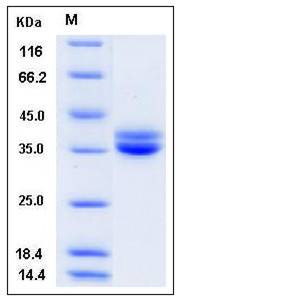Human GPA33 / Glycoprotein-A33 Protein (His Tag)
A33
- 100ug (NPP3902) Please inquiry
| Catalog Number | P11277-H08H |
|---|---|
| Organism Species | Human |
| Host | Human Cells |
| Synonyms | A33 |
| Molecular Weight | The secreted recombinant human GPA33 consists of 225 amino acids and has a predicted molecular mass of 25 kDa. The apparent molecular mass of the rhGPA33 is approximately 35-40 kDa in SDS-PAGE under reducing conditions due to glycosylation. |
| predicted N | Ile 22 |
| SDS-PAGE |  |
| Purity | > 95 % as determined by SDS-PAGE |
| Protein Construction | A DNA sequence encoding the extracellular domain of human GPA33 (Q99795-1) (Met 1-Val 235) was fused with a polyhistidine tag at the C-terminus. |
| Bio-activity | |
| Research Area | Cancer |Oncoprotein & suppressor & biomarker |Tumor biomarker |Tumor antigen |
| Formulation | Lyophilized from sterile PBS, pH 7.4 1. Normally 5 % - 8 % trehalose and mannitol are added as protectants before lyophilization. Specific concentrations are included in the hardcopy of COA. |
| Background | Cell surface A33 antigen, also known as glycoprotein A33, is a single-pass type I membrane protein which is expressed in normal gastrointestinal epithelium and in 95% of colon cancers. GPA33 contains one Ig-like C2-type (immunoglobulin-like) domain and one Ig-like V-type (immunoglobulin-like) domain. The open reading frame encodes a 319-amino acid polypeptide having a putative secretory signal sequence and 3 potential glycosylation sites. The predicted mature protein has a 213-amino acid extracellular region, a single transmembrane domain, and a 62-amino acid intracellular tail. Intracellular traffic and recycling to the cell surface appear to play a major role in GPA33 function and to have an influence on its surface density superseding translational regulation. GPA33 has become a promising target of immunologic therapy strategies, but its biologic function and potential role in tumorigenesis are unknown. EpCAM protein and GPA33 mRNA expressions are specific and sensitive markers of Barrett's metaplasia (BM). GPA33 may also play a role in cell-cell recognition and signaling. |
| Reference |
